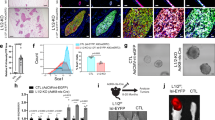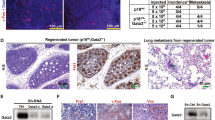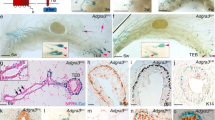Abstract
The transcription factor Gata-3 is a defining marker of the 'luminal' subtypes of breast cancer1,2,3,4. To gain insight into the role of Gata-3 in breast epithelial development and oncogenesis, we have explored its normal function within the mammary gland by conditionally deleting Gata-3 at different stages of development. We report that Gata-3 has essential roles in the morphogenesis of the mammary gland in both the embryo and adult. Through the discovery of a novel marker (β3-integrin) of luminal progenitor cells and their purification, we demonstrate that Gata-3 deficiency leads to an expansion of luminal progenitors and a concomitant block in differentiation. Remarkably, introduction of Gata-3 into a stem cell-enriched population induced maturation along the alveolar luminal lineage. These studies provide evidence for the existence of an epithelial hierarchy within the mammary gland and establish Gata-3 as a critical regulator of luminal differentiation.
This is a preview of subscription content, access via your institution
Access options
Subscribe to this journal
Receive 12 print issues and online access
$209.00 per year
only $17.42 per issue
Buy this article
- Purchase on SpringerLink
- Instant access to full article PDF
Prices may be subject to local taxes which are calculated during checkout





Similar content being viewed by others
References
Perou, C. M. et al. Molecular portraits of human breast tumours. Nature 406, 747–752 (2000).
Sørlie, T. et al. Gene expression patterns of breast carcinomas distinguish tumor subclasses with clinical implications. Proc. Natl Acad. Sci. USA 98, 10869–10874 (2001).
Sørlie, T. et al. Repeated observation of breast tumor subtypes in independent gene expression data sets. Proc. Natl Acad. Sci. USA 100, 8418–8423 (2003).
Sotiriou, C. et al. Breast cancer classification and prognosis based on gene expression profiles from a population-based study. Proc. Natl Acad. Sci. USA 100, 10393–10398 (2003).
Hennighausen, L. & Robinson, G. W. Information networks in the mammary gland. Nature Rev. Mol. Cell Biol. 6, 715–725 (2005).
Shackleton, M. et al. Generation of a functional mammary gland from a single stem cell. Nature 439, 84–88 (2006).
Stingl, J. et al. Purification and unique properties of mammary epithelial stem cells. Nature 439, 993–997 (2006).
Pandolfi, P. P. et al. Targeted disruption of the GATA3 gene causes severe abnormalities in the nervous system and in fetal liver haematopoiesis. Nature Genet. 11, 40–44 (1995).
Hendriks, R. W. et al. Expression of the transcription factor GATA-3 is required for the development of the earliest T cell progenitors and correlates with stages of cellular proliferation in the thymus. Eur. J. Immunol. 29, 1912–1918 (1999).
Ting, C. N., Olson, M. C., Barton, K. P. & Leiden, J. M. Transcription factor GATA-3 is required for development of the T-cell lineage. Nature 384, 474–478 (1996).
Pai, S. Y. et al. Critical roles for transcription factor GATA-3 in thymocyte development. Immunity 19, 863–875 (2003).
van Doorninck, J. H. et al. GATA-3 is involved in the development of serotonergic neurons in the caudal raphe nuclei. J. Neurosci. 19, RC12 (1999).
Lim, K. C. et al. Gata3 loss leads to embryonic lethality due to noradrenaline deficiency of the sympathetic nervous system. Nature Genet. 25, 209–212 (2000).
Grote, D., Souabni, A., Busslinger, M. & Bouchard, M. Pax 2/8-regulated Gata 3 expression is necessary for morphogenesis and guidance of the nephric duct in the developing kidney. Development 133, 53–61 (2006).
van der Wees, J. et al. Hearing loss following Gata3 haploinsufficiency is caused by cochlear disorder. Neurobiol. Dis. 16, 169–178 (2004).
Kaufman, C. K. et al. GATA-3: an unexpected regulator of cell lineage determination in skin. Genes Dev. 17, 2108–2122 (2003).
Usary, J. et al. Mutation of GATA3 in human breast tumors. Oncogene 23, 7669–7678 (2004).
Kurek, D., Garinis, G. A., van Doorninck, J. H., van der Wees, J. & Grosveld, F. G. Transcriptome and phenotypic analysis reveals Gata3-dependent signalling pathways in murine hair follicles. Development DOI: 10.1242/dev.02721 (2006).
Jonkers, J. et al. Synergistic tumor suppressor activity of BRCA2 and p53 in a conditional mouse model for breast cancer. Nature Genet. 29, 418–425 (2001).
Andl, T., Reddy, S. T., Gaddapara, T. & Millar, S. E. WNT signals are required for the initiation of hair follicle development. Dev. Cell 2, 643–653 (2002).
van Genderen, C. et al. Development of several organs that require inductive epithelial-mesenchymal interactions is impaired in LEF-1-deficient mice. Genes Dev. 8, 2691–2703 (1994).
Wagner, K. U. et al. Cre-mediated gene deletion in the mammary gland. Nucleic Acids Res. 25, 4323–4330 (1997).
Wagner, K. U. et al. Spatial and temporal expression of the Cre gene under the control of the MMTV–LTR in different lines of transgenic mice. Transgenic Res. 10, 545–553 (2001).
Tong, Q. et al. Function of GATA transcription factors in preadipocyte–adipocyte transition. Science 290, 134–138 (2000).
Sleeman, K. E., Kendrick, H., Ashworth, A., Isacke, C. M. & Smalley, M. J. CD24 staining of mouse mammary gland cells defines luminal epithelial, myoepithelial/basal and non-epithelial cells. Breast Cancer Res. 8, R7 (2006).
Stingl, J., Eaves, C. J., Zandieh, I. & Emerman, J. T. Characterization of bipotent mammary epithelial progenitor cells in normal adult human breast tissue. Breast Cancer Res. Treat. 67, 93–109 (2001).
Asselin-Labat, M. L. et al. Steroid hormone receptor status of mouse mammary stem cells. J. Natl Cancer Inst. 98, 1011–1014 (2006).
Van Esch, H. et al. GATA3 haplo-insufficiency causes human HDR syndrome. Nature 406, 419–422 (2000).
Patient, R. K. & McGhee, J. D. The GATA family (vertebrates and invertebrates). Curr. Opin. Genet. Dev. 12, 416–422 (2002).
Hattori, N., Kawamoto, H., Fujimoto, S., Kuno, K. & Katsura, Y. Involvement of transcription factors TCF-1 and GATA-3 in the initiation of the earliest step of T cell development in the thymus. J. Exp. Med. 184, 1137–1147 (1996).
Sum, E. Y. et al. Loss of the LIM domain protein Lmo4 in the mammary gland during pregnancy impedes lobuloalveolar development. Oncogene 24, 4820–4828 (2005).
Visvader, J. E. et al. The LIM domain gene LMO4 inhibits differentiation of mammary epithelial cells in vitro and is overexpressed in breast cancer. Proc. Natl Acad. Sci. USA 98, 14452–14457 (2001).
Wilkinson, D. G. ed. In Situ Hybridization. A Practical Approach. (Oxford University Press, New York, 1992).
Acknowledgements
We are grateful to S. Holroyd and K. Johnson for expert technical assistance, F. Vaillant, J. Adams and K. Lim for discussions, S. Mihajlovic for histology, F. Battye and K. Field for FACS support, K.-U. Wagner and L. Hennighausen for WAP–cre and MMTV–cre transgenic mice, J. Jonkers for K14–cre mice, and H. Clevers for Lef1 plasmid. G.J.L. and J.E.V. are Research Fellows of the National Health and Medical Research Council (NHMRC) of Australia. M.-L.A.-L. is supported by an INSERM/NHMRC Postdoctoral Fellowship. M.S. was supported by a NHMRC Medical Postgraduate Scholarship. This work was supported by the Victorian Breast Cancer Research Consortium (J.E.V and G.J.L).
Author information
Authors and Affiliations
Corresponding authors
Ethics declarations
Competing interests
The authors declare no competing financial interests.
Supplementary information
Supplementary Information
Supplementary figures S1, S2 and S3 (PDF 466 kb)
Rights and permissions
About this article
Cite this article
Asselin-Labat, ML., Sutherland, K., Barker, H. et al. Gata-3 is an essential regulator of mammary-gland morphogenesis and luminal-cell differentiation. Nat Cell Biol 9, 201–209 (2007). https://doi.org/10.1038/ncb1530
Received:
Accepted:
Published:
Issue Date:
DOI: https://doi.org/10.1038/ncb1530



